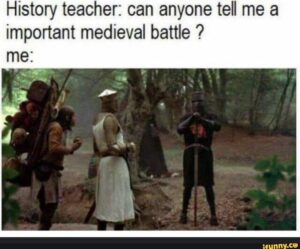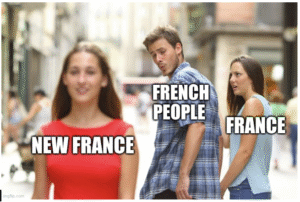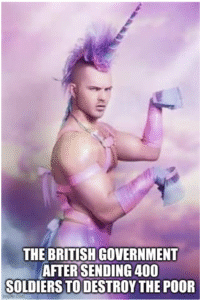The question of what is the digital culture of education currently, I believe is divided. There are those who are embracing technology and working to integrate all the amazing tools that exist, sometimes specifically for the purpose of education. However, there are also those who avoid and might even go as far as referring to themselves as a form of luddite. Without a doubt, whatever the personal or professional opinions about technology within education are, it is here to stay and is a tool that can be used in the classroom.

A little history joke, that I hope someone gets!
In regard to memes, I feel like they are something that students understand and can connect with. So, they absolutely have a place within the classroom. I appreciate the nuances behind a meme, and the layering of knowledge that can happen to have students understand and also express their understanding by creating something like a meme.
I teach history, and let’s be honest, as adults we tend to have a greater appreciation for the subject than teenagers. I find that I am often stretching myself and changing to make the subject, and assignments relevant and interesting so that the teenagers will actually do the work. In my Canadian history class, I had students create memes that connected to New France and the Rebellions of 1837/8. They were to draw a connection to the present if they can, or to show their understanding of the events using typical meme images from today (obviously, since memes did not exist in 1837).


The two pictures above are screenshots of memes students created for the assignment last semester. The first image, is a picture that I feel we have ALL seen used in a meme. I love that they drew a connection to the historical content with an image that has been insanely popular. The second one really highlights the sense of humour of that student. That is part of the joy in giving students that creative license and connecting it to the content we are learning about, is their individual creativity can really be highlighted.
Now, is there a negative side to this? I mean, there is always the chance that students can be wildly inappropriate with what they choose, but I tried to monitor to check on what direction students were going with this before it was finalized. I also printed these off and posted them to my bulletin board and found that ALL of my classes looked at every single one and understood the historical event based on the memes. I will take that as a teaching win. There were definitely a couple of students who needed help, as the hidden or double meaning in memes is an upper-level thinking concept, but that is the reality of teaching and learning.
Participatory culture, is something that I think we are all a part of, but don’t think about as a concept or term. This idea that we are not just observers anymore, that we are actively creating the content which we enjoy. We have created so much content that we have also created doomscrolling (which I didn’t realize is one word). Which is one impact of participatory culture, how it affects us, mostly negatively according to an article linked below.
What Is Doomscrolling? Why We Do It & How It Affects Us
When it comes to education, it is interesting that we as a people are now considered mass consumers of knowledge. As mass consumers and producers students have a much wider general knowledge of topics and information tied to technology, but not necessarily to many of the things that are actually taught in the classroom. I will find the rare student who spends a bulk of their time on YouTube consuming history videos on the Second World War, and so it benefits them in that one topic. However, how much of the information that students are finding on YouTube or other sources accurate and reliable? There are several examples of students being adamant that something is true because they learned it on TikTok, yet, it is very much not true. And sometimes, if you look, you can find several sources where someone is doing exactly that, disproving a video posted that has gone viral as “true”.
Which brings up the next point, how should educators help students critically engage with digital information? I believe that educators need to be doing exactly that, educating about misinformation and how to identify content that is generated and not accurate. Resources like Ctrl-F, developed by CIVIX (funded by Elections Canada) have some excellent resources that are great to use within the classroom. Ctrl-F main goal is to teach media literacy, which is something that we NEED more of within our youth. It has a great lesson that has students reverse look up an image on Google in order to decide whether it has been altered or is fake. These are essential critical thinking skills that many adults do not have, so if our youth can be smarter when engaging in media, it can only benefit us in the long run.
Overall, I think that the digital culture of education is positive, as long as we focus on the education side of things. It is when we leave education behind and have to manage behaviour that is doesn’t remain positive. And that is unfortunate, because the world really is at our fingertips with the technology that is available to us in just our pocket.
I really enjoyed reading your post! Your example of using memes in your Canadian history class is such a creative and engaging way to help students connect with historical content. You made a great point about the “hidden or double meaning” in memes requiring higher-level thinking. It’s true that decoding or creating memes pushes students to synthesize information in clever ways. I also appreciate your reflection on participatory culture and the potential downside of misinformation in the digital age. The resource you mentioned—Ctrl-F—sounds excellent for building critical media literacy. Your post emphasizes how teachers must establish a balance in digital learning environments between creativity and accountability. Seeing how you are assisting students in developing into critical thinkers and engaged members of the modern digital society is encouraging!
Shayna, I appreciate that you included a Monty Python meme, it’s a classic! I actually showed it to my eight-year-old a little while ago and now whenever he trips or bumps into something, he’ll grin and say, “I’m not dead yet!” Out of context, it sounds pretty strange, but to anyone who knows the reference, it’s hilarious. It just goes to show how humor and shared cultural moments can bridge generations.
I really like your idea of having students create a meme that could have existed in history. It’s such a clever and relevant way to help them demonstrate understanding while engaging with the material creatively. I think it’s wise for educators to take a step back, look at the learning outcomes, and ask: “What other ways can students show this skill or knowledge?” You’ve modeled exactly that flexibility, and it clearly paid off if every class stopped to look at the finished memes!
Since they drew so much attention, it could be fun to take it a step further by making a few of your own( some misleading ones) and challenging students to identify which are inaccurate. It would turn their interest into learning and tie directly into the kind of critical digital literacy you’re already promoting. Teaching them to question, verify, and reflect on what they see is just as essential as teaching history itself.
What stands out most in your approach is how it blends engagement with awareness. You’re showing students that digital culture isn’t something to avoid but it’s something to understand, critique, and use responsibly.